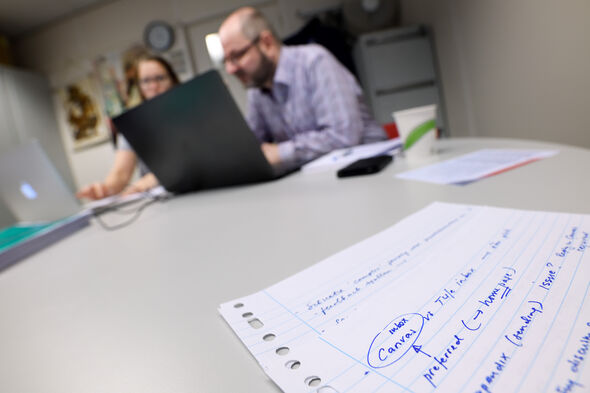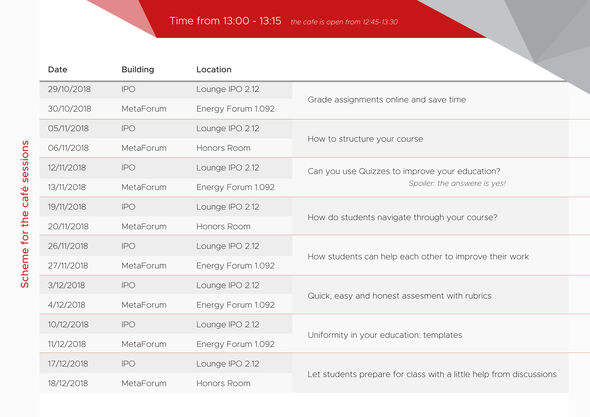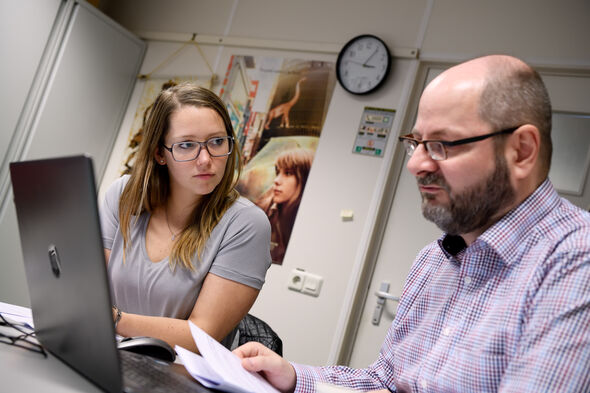
- Education , Student
- 24/10/2018
Support with Canvas should boost its use
One lecturer posts their lesson material at site A in Canvas, while another does that at site B. That's confusing for students, who often have difficulty finding their information. TU/e has now hired two educational consultants who will help lecturers to structure Canvas and enable them to make better use of all the online education system has to offer. They'll be using inspiration sessions and personal training to get their message across. The first Canvas cafe, where lecturers can walk in with questions, will be held next week.
“So cool that students have flagged up this need and that they are being listened to,” says educational consultant Nienke Stumpel. Together with Chantal Westerveld, her colleague at software and consultancy firm Drieam, she will be boosting the use of Canvas over the coming three months. Westerveld: “Most lecturers have the basic knowledge but aren't always aware how they can make better use of Canvas as an educational resource. This means using possibilities like peer review and discussion. Above all, lecturers don't always know where best to post certain information.”
Room for improvement
Signals that lecturers aren't using Canvas uniformly had already been received at Education & Student Affairs (ESA), tells Wilma Groenendaal, educational advisor at TU/e. “We've recently been asking the study associations about this, and requesting suggestions of good examples of its use and less good ones. The various associations identified similar points where improvement is required. For example, they would like to see lecturers structure the home pages in the same way.”

The two trainers are not planning to impose any particular structure or to make a certain approach mandatory. Westerveld: “We'll be encouraging uniformity and want to show lecturers what is possible. We will bat around ideas with them; what should the templates contain? Where would it be logical to post certain information? A Bachelor's final project requires a different layout than group work. So differences will remain, including between programs, and that is fine. However, these differences can be minimized by giving general guidelines and working with templates.”
Stumpel and Westerveld plan to meet their objectives in various ways. Among them, the Canvas cafes, starting Monday October 29, where lecturers can come along every week on Monday and Tuesday. On these days they have set aside 15 minutes in which they will answer lecturers' questions. Lunch will also be provided.
Read on below the panel.
The walk-in sessions are held every Monday in the IPO building and every Tuesday in MetaForum, both from 13:00 to 13:15 hrs. The cafe is open from 12:45 to 13:30 hrs. In IPO the venue is the Lounge (2.12) and in MF it will usually be the Energy Forum (1.092). See the schedule below (click to enlarge).
At five departments, lecturers will be visited individually by the trainers or lecturer support officers, thus benefiting from personal advice. Westerveld: “These are the departments with sufficient lecturer support officers: Biomedical Engineering, Chemical Engineering and Chemistry, Industrial Engineering & Innovation Sciences, Mathematics and Computer Science, and Built Environment. It is hoped that the input of the lecturer support officers will have a ripple effect. And that this effect will not stop once we go.” Moreover, in a couple of weeks' time, all the lecturers will receive various templates they can use.
"Canvas is more complex, but does offer a lot of possibilities"
Ad Kleingeld is an assistant professor at the Human Performance Management group in the department IE&IS. Chantal Westerveld has now helped him on two occasions with structuring Canvas. Last year, he was already learning about the possibilities offered by the system.
“It is very practical to be able to have things explained to you at your desk. Personally, I don't have the time to read all kinds of manuals. It's not that I've been getting criticism from students about the layout, but I did see a more student-friendly approach was being taken by some other courses. Chantal has helped me create modules where I can post the course information. And we have worked on the home page, so that, among other things, students see immediately where the highlights of the study guide are posted."
'It's not Apple'
According to Kleingeld, the options available to him in Canvas were immediately neither easy to grasp nor logical. "It's not Apple. We did have some explanation when it was introduced, but it was not enough to address all the options. So in the beginning I used it mainly as a place to keep my documents. Canvas is more complex than the last system, but then again you can do more with it.
Last year I also got help. That was thanks to a project in the department related to education innovation. I learned how you can work with online rubrics in what is called the Speedgrader application to assess reports and give online feedback. Until then, I was still working on paper. Still, the paperless office is the future and it's forward-looking to start introducing blended learning. It's simply smart to make a start now."


Discussion